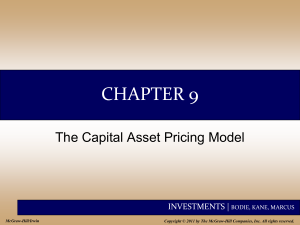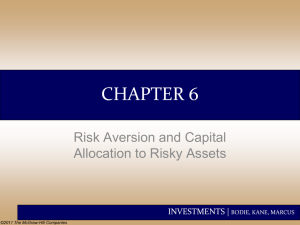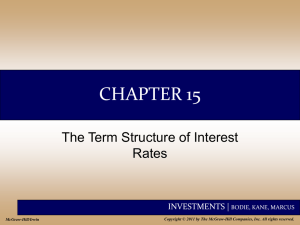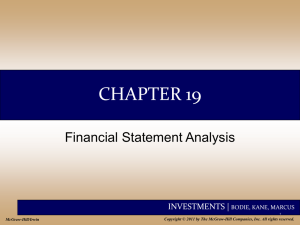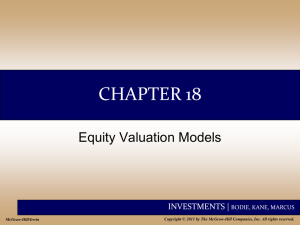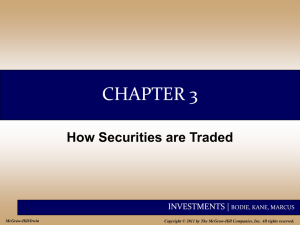Capital allocation
advertisement
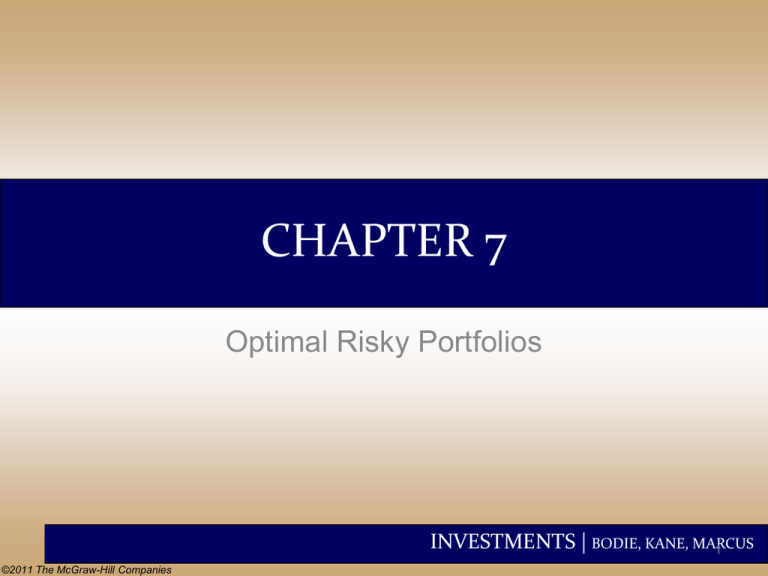
CHAPTER 7 Optimal Risky Portfolios INVESTMENTS | BODIE, KANE, MARCUS 1 ©2011 The McGraw-Hill Companies The Investment Decision • Top-down process with 3 steps: 1. Capital allocation between the risky portfolio and risk-free asset 2. Asset allocation across broad asset classes 3. Security selection of individual assets within each asset class INVESTMENTS | BODIE, KANE, MARCUS 2 ©2011 The McGraw-Hill Companies Diversification and Portfolio Risk • Market risk – Systematic or nondiversifiable • Firm-specific risk – Diversifiable or nonsystematic INVESTMENTS | BODIE, KANE, MARCUS 3 ©2011 The McGraw-Hill Companies Figure 7.1 Portfolio Risk as a Function of the Number of Stocks in the Portfolio INVESTMENTS | BODIE, KANE, MARCUS 4 ©2011 The McGraw-Hill Companies Figure 7.2 Portfolio Diversification INVESTMENTS | BODIE, KANE, MARCUS 5 ©2011 The McGraw-Hill Companies Covariance and Correlation • Portfolio risk depends on the correlation between the returns of the assets in the portfolio • Covariance and the correlation coefficient provide a measure of the way returns of two assets vary INVESTMENTS | BODIE, KANE, MARCUS 6 ©2011 The McGraw-Hill Companies Two-Security Portfolio: Return rp rP Portfolio Return wr D D wE r E wD Bond Weight rD Bond Return wE Equity Weight rE Equity Return E (rp ) wD E (rD ) wE E (rE ) INVESTMENTS | BODIE, KANE, MARCUS 7 ©2011 The McGraw-Hill Companies Two-Security Portfolio: Risk p2 wD2 D2 wE2 E2 2wD wECovrD , rE D2 = Variance of Security D 2 E = Variance of Security E CovrD , rE = Covariance of returns for Security D and Security E INVESTMENTS | BODIE, KANE, MARCUS 8 ©2011 The McGraw-Hill Companies Two-Security Portfolio: Risk • Another way to express variance of the portfolio: P2 wD wDCov(rD , rD ) wE wE Cov(rE , rE ) 2wD wE Cov(rD , rE ) INVESTMENTS | BODIE, KANE, MARCUS 9 ©2011 The McGraw-Hill Companies Covariance Cov(rD,rE) = DEDE D,E = Correlation coefficient of returns D = Standard deviation of returns for Security D E = Standard deviation of returns for Security E INVESTMENTS | BODIE, KANE, MARCUS 10 ©2011 The McGraw-Hill Companies Correlation Coefficients: Possible Values Range of values for 1,2 + 1.0 > > -1.0 If = 1.0, the securities are perfectly positively correlated If = - 1.0, the securities are perfectly negatively correlated INVESTMENTS | BODIE, KANE, MARCUS 11 ©2011 The McGraw-Hill Companies Correlation Coefficients • When ρDE = 1, there is no diversification P wE E wD D • When ρDE = -1, a perfect hedge is possible wE D D E 1 wD • How to solve for this weights? INVESTMENTS | BODIE, KANE, MARCUS 12 ©2011 The McGraw-Hill Companies Three-Asset Portfolio E (rp ) w1E (r1 ) w2 E (r2 ) w3 E (r3 ) p2 w1212 w22 22 w32 32 2w1w21,2 2w1w31,3 2w2 w3 2,3 INVESTMENTS | BODIE, KANE, MARCUS 13 ©2011 The McGraw-Hill Companies Figure 7.3 Portfolio Expected Return as a Function of Investment Proportions INVESTMENTS | BODIE, KANE, MARCUS 14 ©2011 The McGraw-Hill Companies Figure 7.4 Portfolio Standard Deviation as a Function of Investment Proportions INVESTMENTS | BODIE, KANE, MARCUS 15 ©2011 The McGraw-Hill Companies The Minimum Variance Portfolio • The minimum variance portfolio is the portfolio composed of the risky assets that has the smallest standard deviation, the portfolio with least risk. • When correlation is less than +1, the portfolio standard deviation may be smaller than that of either of the individual component assets. • When correlation is 1, the standard deviation of the minimum variance portfolio is zero. INVESTMENTS | BODIE, KANE, MARCUS 16 ©2011 The McGraw-Hill Companies Figure 7.5 Portfolio Expected Return as a Function of Standard Deviation INVESTMENTS | BODIE, KANE, MARCUS 17 ©2011 The McGraw-Hill Companies Correlation Effects • The amount of possible risk reduction through diversification depends on the correlation. • The risk reduction potential increases as the correlation approaches -1. – If = +1.0, no risk reduction is possible. – If = 0, σP may be less than the standard deviation of either component asset. – If = -1.0, a riskless hedge is possible. INVESTMENTS | BODIE, KANE, MARCUS 18 ©2011 The McGraw-Hill Companies Figure 7.6 The Opportunity Set of the Debt and Equity Funds and Two Feasible CALs INVESTMENTS | BODIE, KANE, MARCUS 19 ©2011 The McGraw-Hill Companies The Sharpe Ratio • Maximize the slope of the CAL for any possible portfolio, P. • The objective function is the slope: SP E (rP ) rf P • The slope is also the Sharpe ratio. INVESTMENTS | BODIE, KANE, MARCUS 20 ©2011 The McGraw-Hill Companies Figure 7.7 The Opportunity Set of the Debt and Equity Funds with the Optimal CAL and the Optimal Risky Portfolio INVESTMENTS | BODIE, KANE, MARCUS 21 ©2011 The McGraw-Hill Companies Figure 7.8 Determination of the Optimal Overall Portfolio INVESTMENTS | BODIE, KANE, MARCUS 22 ©2011 The McGraw-Hill Companies Figure 7.9 The Proportions of the Optimal Overall Portfolio INVESTMENTS | BODIE, KANE, MARCUS 23 ©2011 The McGraw-Hill Companies Markowitz Portfolio Selection Model • Security Selection – The first step is to determine the riskreturn opportunities available. – All portfolios that lie on the minimumvariance frontier from the global minimum-variance portfolio and upward provide the best risk-return combinations (i.e. this defines the efficient set of mean-st.dev) INVESTMENTS | BODIE, KANE, MARCUS 24 ©2011 The McGraw-Hill Companies Figure 7.10 The Minimum-Variance Frontier of Risky Assets INVESTMENTS | BODIE, KANE, MARCUS 25 ©2011 The McGraw-Hill Companies Markowitz Portfolio Selection Model • We now search for the CAL with the highest reward-to-variability ratio INVESTMENTS | BODIE, KANE, MARCUS 26 ©2011 The McGraw-Hill Companies Figure 7.11 The Efficient Frontier of Risky Assets with the Optimal CAL INVESTMENTS | BODIE, KANE, MARCUS 27 ©2011 The McGraw-Hill Companies Markowitz Portfolio Selection Model • Everyone invests in P, regardless of their degree of risk aversion. – More risk averse investors put more in the risk-free asset. – Less risk averse investors put more in P. INVESTMENTS | BODIE, KANE, MARCUS 28 ©2011 The McGraw-Hill Companies Capital Allocation and the Separation Property • The separation property tells us that the portfolio choice problem may be separated into two independent tasks – Determination of the optimal risky portfolio is purely technical. • Under CAPM we known the answer “without even looking”. – Allocation of the complete portfolio to Tbills versus the risky portfolio depends on personal preference. INVESTMENTS | BODIE, KANE, MARCUS 29 ©2011 The McGraw-Hill Companies Figure 7.13 Capital Allocation Lines with Various Portfolios from the Efficient Set INVESTMENTS | BODIE, KANE, MARCUS 30 ©2011 The McGraw-Hill Companies The Power of Diversification n • Remember: 2 P i 1 n w w Cov(r , r ) j 1 i j i j • If we define the average variance and average covariance of the securities as: 1 n 2 i n i 1 2 n 1 Cov n(n 1) j 1 j i n Cov(r , r ) i 1 i j INVESTMENTS | BODIE, KANE, MARCUS 31 ©2011 The McGraw-Hill Companies The Power of Diversification • We can then express portfolio variance as: 1 2 n 1 Cov n n 2 P INVESTMENTS | BODIE, KANE, MARCUS 32 ©2011 The McGraw-Hill Companies Table 7.4 Risk Reduction of Equally Weighted Portfolios in Correlated and Uncorrelated Universes INVESTMENTS | BODIE, KANE, MARCUS 33 ©2011 The McGraw-Hill Companies


